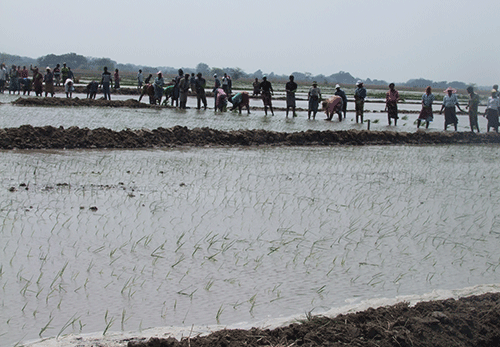The Kalimbeza rice project, envisaged to become the major rice producer in the Zambezi region, contributing towards food security in Namibia, has yielded little to poor results.
In January last year, government, through the ministry of agriculture, bailed out the project, which was on the brink of collapse, with N$7.1 million to recoup its operations.
This came as a result of the farm that has not planted rice for the last two years due to factors such as disconnected electricity, non-payment of employee salaries, a lack of fuel, uneven fields and wrecked equipment.
Zambezi governor, Lawrence Sampofu, when he delivered the state of the region address yesterday, said the total fenced off area is 229 hectares (ha) but the irrigable land at the project is 150 ha, while the rest is patches of sand that cannot be used for planting rice.
“The levelling of the paddies contributed significantly to the delay in the planting of rice, and only 40 ha was planted out of 50 ha that was planned to be planted with the short variety,” he reported.
The Kalimbeza project currently grows three varieties of rice, namely, Supa, Irga and Angola.
Traditional authorities have availed portions of land for green schemes irrigation and development.
Sampofu said the occupation of these pieces of land will see the realisation of job creation and boost food security.
This includes 5 000 ha at Singalamwe in Kongola constituency and 890 ha at Kongola, situated some 500m from the Kwandu River.
The other is the 2 000 ha of land at Lyanshulu in Judea Lyabboloma constituency adjacent to the Kwandu River.
Another 5 000 ha of land was allocated at Sachona in Judea Lyabboloma constituency, while 1 000 ha of land was given at Muyako in Katima Mulilo Rural constituency.
A total of 10 000 ha have been allocated at Lusese and Nankonde in the flood prone areas of Kabbe North and South constituencies.
Due to the diverse effects of the Covid-19 pandemic, the region recorded a decrease in income generated by conservancies.
An amount of N$14.5 million was generated by the conservancies compared to N$25 million generated in 2019/20 and no tangible projects were implemented. Also, new jobs were created in Zambezi conservancies including Kyaramacan Association, and the job categories ranged from fish guards, game guards, and secretaries.
As a social response to the community, a total of 194 024 kg of meat from conservation hunting was distributed to communities within conservancies.
Three park management plans of Mudumu, Nkasa-Rupara and Bwabwata national parks were revised and approved, and are currently in the implementation phase.
Therefore, he said operational guidelines on how to implement the management plans and the action plan were developed and are now being implemented.
On forestry, trade in forest products from community forests generated N$200 000. Community forest offices received donations of furniture and IT equipment to the value of N$272 150 after the completion of constructed offices.
Sikanjabuka Community forest received N$4.5 million to support climate change resilience through agroforestry initiatives and nursery establishment.
A total number of 160 farmers benefited from horticultural seeds, garden tools and irrigation equipment while160 farmers were trained under horticulture.
Another 60 farmers were trained in conservation agriculture and 19 gardens were supported with solar energy technology, benefiting 67 farmers. –anakale@nepc.com.na
Pic: Kalimbeza rice


